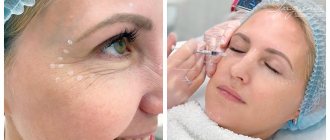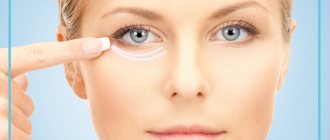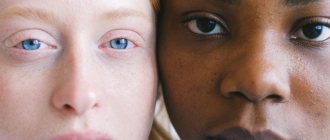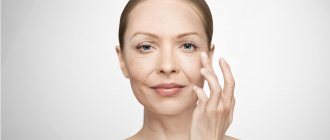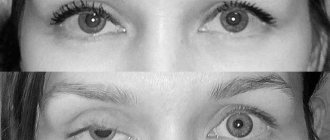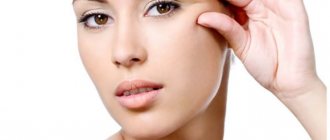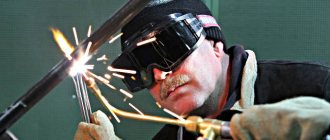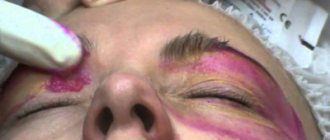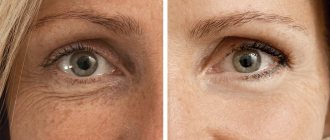An expressive look is considered one of the characteristics of a beautiful, well-groomed appearance. Unfortunately, the inevitable age-related changes are incompatible with a beautiful, attractive look. The good news is that these changes are, in most cases, easy to correct. The same can be said about congenital or acquired deficiencies.
Modern aesthetic medicine offers a wide number of ways to solve this problem. You can resort to the services of both a cosmetologist and a plastic surgeon. The final correction method will depend on a number of factors, such as the severity of the changes or the overall condition of the skin. The choice of the optimal technique remains with the medical specialist, who, however, takes into account all the wishes of the patient.
Correction techniques
Eyelid contouring is most often understood as cosmetic procedures. It is possible to restore the lost freshness of the skin using several types of cosmetic manipulations, for example, by injecting fillers or inserting threads under the skin. These procedures are quite easy and do not require a long rehabilitation period. But this type of correction is not suitable for everyone.
If the changes are very pronounced, the patient will be recommended the help of a plastic surgeon and a full-fledged surgical operation - blepharoplasty. Surgical correction allows you to cope with even the most severe wrinkles, sagging tissue and other changes associated with age. Blepharoplasty is also indicated for a number of congenital defects or those resulting, for example, from injury.
Types of wrinkles around the eyes
As a rule, the first wrinkles in the form of “crow’s feet” appear in the outer corners of the eyes at 25-30 years of age. Deep wrinkles form at the age of 30-40. This process develops gradually and reaches a peak at 55-60 years.
According to the degree of severity, they are distinguished:
- superficial wrinkles
, they appear the very first and form in the epidermis area. These wrinkles include “crow’s feet”. - deep wrinkles
form in the dermal layer and subcutaneous fat. At the same time, the skin loses its firmness and elasticity, becomes dry, flabby, and begins to sag.
Due to their occurrence, there are three types of wrinkles:
- Facial - develop as a result of strong tension in the facial muscles and excessive facial expressions;
- Age-related - occur as a result of age-related changes in the structures of the skin;
- Gravitational - develop as a result of sagging skin due to loss of elasticity and firmness.
Also, regardless of the causes and severity, all wrinkles are divided into:
- dynamic - not visible when the facial muscles are relaxed;
- static - visually noticeable even in a calm state.
Indications
The most common reason for seeking the services of a cosmetologist or surgeon is, of course, age-related changes. The first changes begin to appear at the age of 25. From this moment on, the skin begins to gradually lose elasticity and firmness, loses freshness and tenderness. The eyelids sag, and the first wrinkles appear around the eyes. The older a person gets, the less elastin and collagen the body produces, which affects the condition of the skin.
Eyelid contouring is an effective method of combating age-related changes.
Contour plastic surgery will help to cope with a number of problems. It is recommended for patients with complaints such as:
- formation of facial wrinkles,
- the appearance of crow's feet,
- dark circles and bags under the eyes,
- drooping eyelids (ptosis),
- hyperpigmentation and more.
Indications for the procedure are predominantly aesthetic in nature and dictated by the patient’s desire to get rid of certain external defects. In rare cases, an acquired or congenital feature may be an indication. For example, drooping eyelids due to the anatomical structure of the eye area, interfering with normal vision, are also an indication. But in such situations, blepharoplasty is usually recommended rather than cosmetology.
When and why do wrinkles occur around the eyes?
The epidermal layer in the periorbital region is very thin, about 0.5 mm, which is almost four times smaller than in any part of the face. In addition, the skin around the eyes has virtually no subcutaneous fat, sebaceous and sweat glands. The collagen fibers in this area form a sparse mesh structure that is quickly destroyed and slowly restored. All this contributes to the early formation of wrinkles.
It is believed that for most people, the first shallow wrinkles in the periorbital area appear at 25-30 years of age. But this is very generalized data. Sometimes the first signs of aging can appear at an earlier age.
The appearance of wrinkles is influenced by many factors, including:
- hereditary predisposition to early skin aging;
- features of the anatomical structure of the face, in particular deep-set eyes, drooping upper eyelids, drooping eyebrows;
- dry skin;
- the presence of autoimmune and/or endocrine diseases that affect cellular metabolic processes, which leads to a slowdown in the production of elastin and collagen in tissues;
- unhealthy lifestyle, frequent stress, poor sleep and inadequate rest, chronic fatigue;
- unbalanced nutrition leads to the development of vitamin deficiency and a lack of microelements important for the skin;
- bad habits (smoking, alcohol, drugs);
- poor ecology, in particular, living in megacities or industrial regions with heavily polluted air, due to which the body does not receive enough oxygen;
- the presence of chronic diseases, especially liver pathologies;
- insufficient or improper care of the skin in the eye area, use of low-quality cosmetics or those not intended for the care of the paraorbital area;
- excessive passion for decorative cosmetics, improper application of makeup or use of low-quality products;
- excessive facial expressions;
- unfavorable external influences: significant temperature changes, chapping, especially cold or sea air, excessive exposure to sunlight or very dry air;
- professional activities, such as working at a computer or with small parts, when the eye muscles are under constant tension;
- myopia, since people with poor vision have to constantly squint;
- sleeping on a very high or low pillow, which leads to an uncomfortable position during rest, which disrupts normal blood circulation in the facial skin.
But even if you follow all the rules for caring for the skin around the eyes and lead a healthy lifestyle, sooner or later age-related changes will begin to occur, as a result of which the secretion of collagen and elastin proteins decreases, the layer of subcutaneous fat becomes thinner, the secretion of the sebaceous glands decreases, and the skin becomes flabby. , saggy, wrinkles and furrows form.
Preparation for procedures
In order to obtain an ideal result upon completion of the procedure, the patient must properly prepare for the procedure. The preparation process is similar for both cosmetic and surgical procedures. One to two weeks before the scheduled correction date, you must stop taking blood thinning and hormonal medications. In a few days, eliminate spices, reduce the consumption of salty and spicy foods.
It is also strongly recommended to give up cigarettes and alcohol so as not to complicate your recovery. Three days before plastic surgery, it is advisable not to use cosmetics and facial care, in particular peeling. It is better to postpone playing sports until after rehabilitation.
What is the price?
Contour plastic surgery in Moscow is a popular manipulation. The price range is wide. Remember: the result depends on the professionalism of the doctor and the quality of the filler. Do not skimp on health and beauty, contact licensed clinics with a good reputation. At Dr. Listratenkov’s clinic you will be offered fillers:
- "Surgiderm" produced by the French company Corneal.
- "Belcontour" from the Swiss pharmaceutical concern Hyal Intertrade SA
Both patients and plastic surgeons respond positively to the drugs. The prices for these fillers are quite high. Your doctor will tell you how much facial contouring costs. The price is affected by the complexity of the operation, quantity, and type of filler.
How does plastic surgery work: cosmetology
A common correction option in cosmetology is the injection of filler drugs. In most cases, the basis for the drug is hyaluronic acid, which is responsible for skin elasticity and moisture saturation. The choice of drug is made only by a professional cosmetologist; you are not allowed to prescribe the drug yourself.
An experienced specialist injects the drug with a syringe with a thin needle through several points according to pre-designated markings. The depth of input depends on the volume and complexity of the problems that need to be eliminated. The procedure does not take much time and is performed under local anesthesia. As a rule, several sessions in a cosmetology salon are necessary for complete elimination.
Cosmetic eyelid surgery most often consists of filler injections.
How do fillers act on the body?
The basis of all fillers used in our clinic is hyaluronic acid. This substance is related to our skin - normally the human body produces it itself. Therefore, the drugs are not perceived as something foreign, they help nourish the tissues, stimulate the production of collagen and elastin.
If we talk about the cosmetic effect, then fillers allow you to fill the missing volume - for example, if after severe weight loss your eyes have sunken or the nasolacrimal groove has become too pronounced. When hyaluronic acid is injected into an area where there are wrinkles and folds, the drug literally “pushes” them out from the inside, filling the voids formed due to age-related reasons or too active facial expressions.
How is plastic surgery done: surgery
If the patient has been recommended blepharoplasty, then this plastic surgery takes place in the operating room under the supervision of an experienced surgeon. Like a cosmetologist, the surgeon first applies markings. During the marking operation, small incisions are made through which excess skin and fatty tissue are removed. The tissues are then fixed in their new position. The surgeon applies stitches and a sterile dressing.
Another access option for surgical correction is transconjunctival, in which work is carried out through incisions in the inner mucosa of the eye. This method is characterized by complete invisibility of postoperative traces. But don’t think that the classic technique will leave visible scars - with this method, the incisions are made in the natural crease of the eye and therefore are also unnoticeable to others.
What is eye contour surgery?
This is a non-surgical method of correcting age-related changes, based on injections of hyaluronic acid.
We talked quite a lot about hyaluronic acid. Let me remind you that its molecules allow you to restore elasticity to the skin and moisturize it.
Injections of hyaluronic acid cope with the correction of age-related changes in both women and men. But it should be understood that they are effective when age-related changes are not pronounced. The procedure cannot cope with significant fat deposits or excess connective tissue.
The earlier injections are started, the less dosage required. And the result will be more noticeable.
Some experts recommend starting procedures as early as 25 years of age.
Directly for correcting changes, the optimal age is 30-45 years.
At a later age, there will be no effect from the procedure. I would recommend plastic surgery, such as space facial surgery, which I talked about in my previous articles.
The result lasts for 6-12 months. A repeat procedure will be required later.
Indications for contour plastic surgery are:
- tear trough deformity
- loss of skin elasticity
- sagging skin
- swelling
- fine wrinkles
- dark circles under the eyes
- crow's feet
The procedure will not be effective if you have:
- drooping eyelid
- hernia
- PTO
- pronounced bags under the eyes
Also, injections do not sculpt eyebrows or change the shape of eyes.
Rehabilitation
Regardless of the type of procedure, after completion the patient must follow a number of simple rules in order to get an excellent result. This includes prohibitions on physical activity, visiting baths and saunas, as well as solariums. Exposure to ultraviolet radiation and thermal procedures during the recovery period should be limited to the maximum to avoid the formation of noticeable scars or complications.
Also, at first, you should avoid manipulations associated with aggressive effects on the skin - chemical peeling, exfoliation, scrubs, etc. Do not rub the skin around the eyes. In the first 1-3 days, depending on the type of correction, you should not wash your hair. After the intervention, swelling and bruising will persist for several days - these are normal phenomena. But for any complications that deviate from the norm, you must contact your specialist as soon as possible.
Types of hyaluronic preparations
Juvederm
Gel for correction of nasolacrimal grooves, as well as elimination of nasolabial folds. Safe, effective, high-quality product. the result of the injection lasts from six months to two years.
Mesoeye
A product developed specifically for the skin around the eyes. Allows you to comprehensively solve the main problems. The active substances included in the product improve tissue respiration, thicken the skin, strengthen the walls of blood vessels and provide deep hydration, eliminate puffiness and bags under and above the eyes.
Profhilo, Liquid threads, Collagen, etc.
Photos of lip augmentation with contouring. Cosmetologist Zhukova Ilona
The fillers used were: Sergiderm 24XP, Uviderm ultra, Stylage M, Teosyal kiss
Contour plastic surgery is a medical procedure that helps eliminate age-related changes in appearance, enlarge the lips, correct the shape of the face, reduce nasolabial folds, etc. The procedure is performed by injection using special substances called fillers. These substances are injected under the skin, smoothing wrinkles and filling problem areas with volume. As a rule, fillers are based on injections of hyaluronic acid .
Indications for the procedure:
- Presence of age-related changes and/or wrinkles, furrows
- “Floated”, asymmetrical oval face
- Wrinkles in the eyelid area and corners of the eyes
- Nasolabial folds of different depths
- Changing the shape of the nose, restoring the volume of the cheekbones and chin
- Elimination of asymmetry, changing the shape/volume of lips
- Decreased skin tone, enlarged pores
- Skin defects (atrophic scars, including stretch marks, post-acne)
- Various types of atrophy of facial and body tissues.
